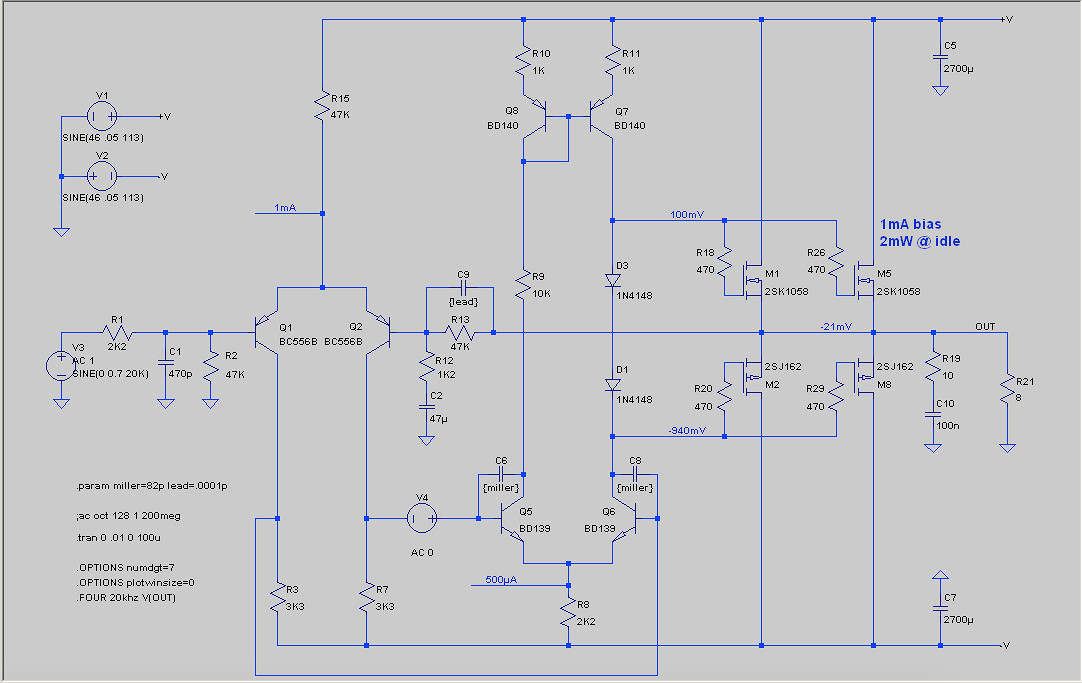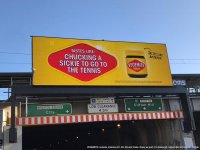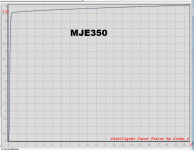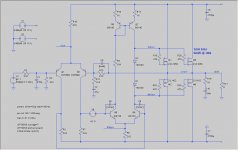You could possibly replace 2sk2013 with a lateral to-220 if you can locate them.
I got some from some guy, I can't quite remember right now.
I got some from some guy, I can't quite remember right now.
Jeff,
You could replace the mosfet in the VAS with a high beta bipolar (possibly lower distortion) a re-bias and have less of a voltage drop to deal with. The key to the performance to this topology being the cascode.
I am not a particularly big fan of mosfets as gain devices but as followers that is another matter entirely.
Jam
You could replace the mosfet in the VAS with a high beta bipolar (possibly lower distortion) a re-bias and have less of a voltage drop to deal with. The key to the performance to this topology being the cascode.

I am not a particularly big fan of mosfets as gain devices but as followers that is another matter entirely.
Jam
Last edited:
You could possibly replace 2sk2013 with a lateral to-220....
Interesting thought. That would nearly halve the rail voltage penalty.
In other developments I could now go back to a BJT CCS instead of the serial JFETS. With the removal of the doubled-up 2SJ109s in the LTP there's little point in 9mA through it, and with 5mA I can get comfortably under a Zetex e-line's max dissipation (280mW vs 800mW for the Zetex derated to 60ºC). The JFETs show less distortion though....
I have some old toshiba bipolar 2sa970 and their complement if Jam thinks these might be superior I could have a look around but not till I get back home.
Not as cascodes but gain devices.
Not as cascodes but gain devices.
Meanwhile back down under...................
That is actually close to where I live.
Depending on how big your output stage is, you can even use TO92 devices in the second stage of the amp to drive the lateral output stage
Jeff,
The 2SA970 and its complement that Pico mentioned are excellent devices for use in this application. The beauty of the cascode is that allows you to use this device in this location (limits the voltage swing seen by the device and thermal issues are no longer a problem).
For the cascode my choice would be the KSC2690 and its complement.
The cascode is esentially in grounded base operation so bandwidth and and the introduction of an unwanted pole should not be an issue.
Jam
P.S. If you need any devices please pm me and I will try to get them to you.
The 2SA970 and its complement that Pico mentioned are excellent devices for use in this application. The beauty of the cascode is that allows you to use this device in this location (limits the voltage swing seen by the device and thermal issues are no longer a problem).
For the cascode my choice would be the KSC2690 and its complement.
The cascode is esentially in grounded base operation so bandwidth and and the introduction of an unwanted pole should not be an issue.
Jam
P.S. If you need any devices please pm me and I will try to get them to you.
Attachments
Last edited:
I reckon try Hitachi design but with jfet input, then use a cascoded to92 device on second stage use Jam's cascode recommendation
Probably gonna be difficult to find but a to220 lateral fet without degeneration in the second stage would be kind of cool.
Depending on how big your output stage is, you can even use TO92 devices in the second stage of the amp to drive the lateral output stage
He he... might work with JamJar, but Beefcake uses 6 pairs of verticals (240/9240s). Probably doesn't really qualify as easy to drive....
P.S. If you need any devices please pm me and I will try to get them to you.
Thanks kindly for the offer. I enjoy hunting down bizarre stuff, though, so I hope not to need to take you up on it. 🙂
He he... might work with JamJar, but Beefcake uses 6 pairs of verticals (240/9240s). Probably doesn't really qualify as easy to drive....
Yeah probably not beefcake, although cascoded for 5Vds you could potentially run 30mA bias through a to92 device.
I was referring to the hitachi lateral design.
Last edited:
...Beefcake uses 6 pairs of verticals...
Have you thought about the puck route, no matching or insulation issues, no source resistors... mine hasn't gone bang yet, biased at 2A, no feedback, less than 100mV offset on start up, drops to less than 20mV when up to temp.
Last edited:
Yeah my puck amp achieves the same sought of results without degeneration and with no time-machine circuitry either.
I didn't use the opto bias. I found the thermistor useful, it helped to minimise warmup offset.
I didn't use the opto bias. I found the thermistor useful, it helped to minimise warmup offset.
Yeah. Same result here
I started looking at the Hitachi topology. Here's the baseline, based on the schematic Jam posted:

While it performs well at lower frequencies (aside from a shockingly poor phase margin), it falls apart at higher frequencies (17% THD20K @ 60W).
The VAS current looks really low to me; raising it to 1.8mA appears to fix the high frequency issue (dropping TDH20K to around 1%).
But there's still that scary phase angle. The AC waveform says it should be oscillating at 400kHz (at least the phase angle goes over 180º at that point, and the gain is still way above unity at +10dB). However, if I feed it a 440kHz signal it shows an ugly -- but non-oscillatory -- sine wave.
I can improve the non-existent phase margin by replacing the Miller compensation with a moderate amount (30p) of lead compensation, but the phase margin is still a paltry 20º.
Thoughts?
While it performs well at lower frequencies (aside from a shockingly poor phase margin), it falls apart at higher frequencies (17% THD20K @ 60W).
The VAS current looks really low to me; raising it to 1.8mA appears to fix the high frequency issue (dropping TDH20K to around 1%).
But there's still that scary phase angle. The AC waveform says it should be oscillating at 400kHz (at least the phase angle goes over 180º at that point, and the gain is still way above unity at +10dB). However, if I feed it a 440kHz signal it shows an ugly -- but non-oscillatory -- sine wave.
I can improve the non-existent phase margin by replacing the Miller compensation with a moderate amount (30p) of lead compensation, but the phase margin is still a paltry 20º.
Thoughts?
Attachments
- Home
- Amplifiers
- Pass Labs
- JamJar: an HPA-1-inspired power amp



